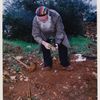On Shabbat Hanukkah (this year, Nov. 29-30), we read an extraordinary passage from the Prophet Zechariah. Speaking during the Babylonian Captivity, he envisions the future Great Menorah, taking its sacred place in a rebuilt Holy Temple.
Zechariah, in visionary, prophetic style, goes beyond the Torah's description of the original Menorah (literally, a Light-bearer). That Menorah was planned as part of the portable Shrine, the Mishkan, in the Wilderness.
First Zechariah describes the Menorah of the future that he sees: "All of gold, with a bowl on its top, seven lamps, and seven pipes leading to the seven lamps." It sounds like the original bearer of the sacred Light. But then he adds a new detail: "By it are two olive trees, one on the right of the bowl and one on the left." (4: 2-3)
And then -- in a passage the Rabbis did not include in the Haftarah reading for Shabbat Hanukkah - -- Zechariah explains that the two olive trees are feeding their oil directly into the Menorah (4: 11-13). No human being needs to press the olives, collect the oil, clarify and sanctify it. The trees alone can do it all.
Now wait! This is extraordinary. What is this Light-Bearer that is so intimately interwoven with two trees? Is the Menorah the work of human hands, or itself the fruit of a tree?
Both, and beyond. In our generation it might be called a "cyborg," a cybernetic organism that is woven from the fruitfulness both of "adamah" (an earthy sprouting from the humus-soil) and "adam" (a human earthling). Just as earth and earthling were deeply intermingled in one of the biblical Creation stories (Gen 2: 7), so the Divine Light must interweave them once again, and again and again, every time the Light is lit in the Holy Temple.
What stirs Zechariah to this uncanny vision? If we listen closely to the Torah's original description of the Menorah for the wandering desert Shrine, we may not be quite so surprised. For the Torah describes a Menorah that has branches, cups shaped like almond-blossoms, blossoms, petals, and calyxes (the tight bundles of green leaves that hold a blossom). (Exodus 25:31-40 and 37:17-24)
In short, a Tree of Light, a Green Menorah. Small wonder that Zechariah envisioned its receiving oil directly from the olive-trees!
Since Zechariah is seen as a Prophet by Christians and Muslims as well as by Jews, his vision may invite all three Abrahamic communities to connect with the Green Menorah Covenant.
And in the more specifically Jewish legend told by the Talmud as the origin of Hanukkah, the Light itself is a miracle. Oil that would normally have been enough only for one day's worth of light lasts for eight days, until more oil can be consecrated.
At the physical level, "One day's oil meets eight days' needs." This is olive oil, a growable, replaceable, sustainable source of light.
Different from coal, oil, and frackable unnatural gas. For all these are limited, and as their easily available sources run out the corporations whose profit depends on them turn to Extreme Extraction: mountaintop destruction for coal, using chemicalized water under extreme pressure to smash shale rock for gas, mining ultra-carbon-heavy Tar Sands, drilling miles deep beneath ocean floors. All these damage and endanger the local communities where they are used.
And now we know that burning these fossil fuels in huge amounts scorches our planet as well. Floods our rivers and our coastal cities, parches our cornfields, imposes higher food prices on everyone and brings famine and starvation upon the hungry billions, storms our subways, melts the snows of Kilimanjaro and the Himalayas that meet the water needs of whole civilizations.
So the Talmudic legend of the eight-day lamp takes on a Prophetic wisdom for our day: Conserving energy.
Seen this way, the Green Menorah can become the symbol of a covenant to renew the miracle of Hanukkah in our own generation: Cutting oil consumption by seven-eighths - and quickly. If not now, when?
If this seems overwhelmingly hard to accomplish against the entrenched power of our own oil empires, Hanukkah also reminds us of the victory of the guerrilla band of Maccabees over the great empire of their generation: Small groups of seemingly powerless human beings can face huge and powerful institutions - and change the world.
But let us not stop at the economic, political, or even ecological levels of meaning. At the spiritual level, "seven" is the number of Fullness and "eight" is the number of "Beyond." So the storied One Light that becomes Eight Lights reminds us that the Infinite is always present in the One.
It reminds us that conserving oil, or coal, or our planet, is not just a political or economic or even ecological decision. It comes when we take into our hearts the knowledge that addiction to material possessiveness, hyper-ownership - needing to make eight bottles of oil in order to "own" the Temple's Light - is likely to be a form of idolatry, not a path to our well-being. Blowing up mountaintops, raping the Gulf of Mexico, mining Tar Sands, fracking shale are likely to be forms of idolatry, not paths to our well-being.
Beyond every "thing" is the Infinite - and the Infinite is always present when we choose to light the Light.
